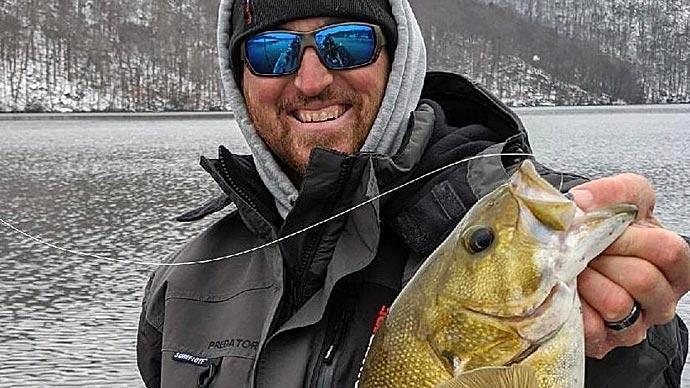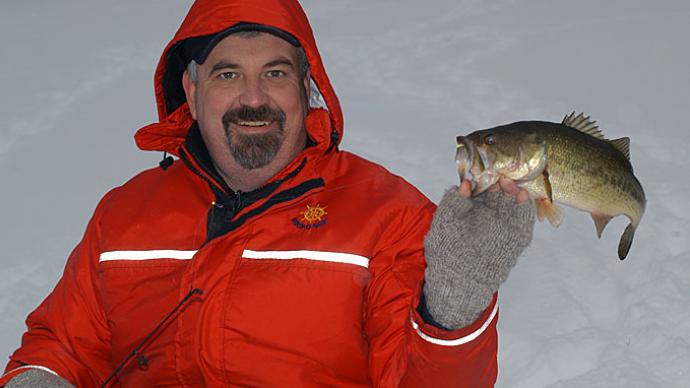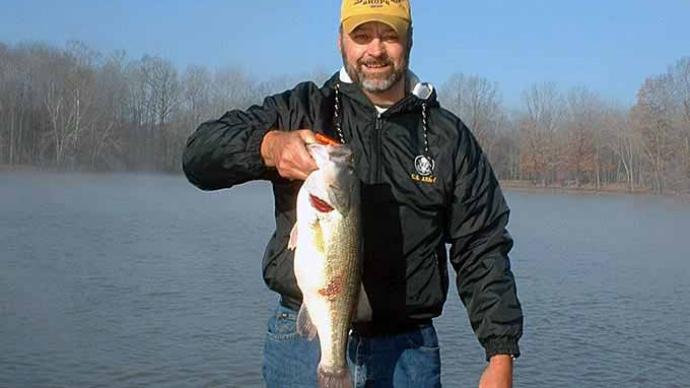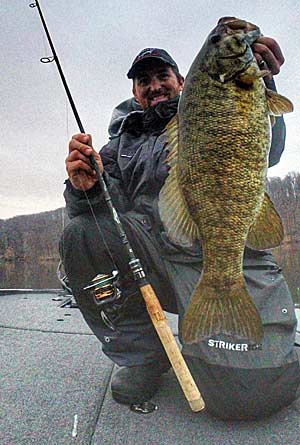
When Bassmaster Elite Series angler Paul Mueller finds bass on his electronics that won’t bite standard presentations, he knows there’s only one thing to do. “That’s when you have to get creative,” he said. That might be tying on a different style or color lure or fishing the same one differently.
Mueller’s goal is to find a lure or presentation that those bass haven’t seen. “That’s how new techniques and lures come about,” he said. Giant flutter spoons are a prime example. Almost as long as your forearm, they give musky anglers second thoughts. But bass anglers, who passed on them at first, now regularly use them to catch bass from deep-water spots across the South. “Keep your eyes and mind open,” he said.
Some of Mueller’s hottest ideas have come on his coldest fishing trips. The Connecticut resident spends many winter days catching various species through the ice, including bass. While the tackle and techniques he uses were developed for ice fishing, many of them give him an advantage in open water when it’s at its coldest. “There are things that can transfer to super early or super late in the season or the South, the middle of the winter,” he said.
Changing mood
Mueller said most anglers are surprised that bass can be targeted through the ice, though catching them can be more challenging than panfish, walleye, or pike. He said that’s especially true with largemouth. They live in a shallower environment, so ice anglers must be stealthy and patient. After the commotion of drilling holes, spots must rest, providing bass time to reset.
Mueller lacks the patience that largemouth demand, so he prefers smallmouth swimming in deeper water. The additional depth is a buffer, making them less spooky. They’re more fun, too. “Smallies through the ice are crazy,” he said. When the ice is thick enough to bear his weight and snow cover safely hasn’t collected, those that he hooks put on a show. “They will look like they’re trying to jump, then smack into the underside of the ice,” he said.
Ice fishing allows Mueller to study how bass behave in cold water. He finds they bite best early and late in the season when the water temperature is at its relative warmest. In between, cold water slows their metabolism to the point that extra effort is needed to convince them to bite. The most consistent bite is in deep water, which is often the warmest.
Dress for success
Clothing is one piece of ice-fishing equipment that easily transitions to open-water fishing. “Many guys don’t fish in the cold because they don’t want to be cold,” he said. “You want to be comfortable. You can’t put a price on that.”
Mueller wears Striker’s Predator jacket and bibs. “I use it from October to early May,” he said. They were designed for ice fishing, so they’re warm. He always wore thermals under previous suits, but he hasn’t with this one.
The Predator offers another significant advantage: It’s made with Sureflote, a material that will float the wearer. That’s an important safety feature in cold water when hypothermia is an immediate danger for anyone that goes overboard. And while it’s always ready if you need it, you won’t notice it. “The main thing is that [the suit] is comfortable,” he said. “It’s not heavy.”
It can be challenging to keep your hands warm while maintaining the agility to tie knots or land bass. “Most gloves cause you to lose feel,” Mueller said. And thinner ones aren’t warm. He believes he found the perfect mix in Striker’s Stealth glove, which is waterproof, breathable, and outfitted with a silicone grip on its palm. It stretches with his movements and keeps his hands dry and warm.
Choose compact lures
Rapala’s Jigging Rap, single upturned hooks, hanging treble hook, and small plastic bill, is a perennial producer through the ice. But its prowess in open water is being discovered by more anglers. It can be cast and retrieved with short snaps, but it’s best when fished vertically in deep water. “It doesn’t do the same movement twice,” Mueller said.
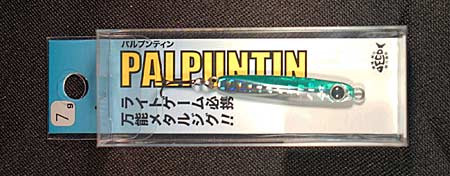
Mueller calls the Jigging Rap the first ice-fishing lure to make it in open water. But that may have happened earlier than most bass anglers realize. “Years ago, guys around me kept it so quiet — hush, hush,” he said. The internet and social media mean bass lures and fishing techniques don’t stay secret for long today. But even those haven’t shined too bright of a light on using other ice-fishing lures in open water.
Spoons work anytime bass are in deep water, though certain ones produce best in certain situations. A different shape or weight will catch isolated bass, while a different one will fire up schools. “Each has its place,” he said. “It just takes a little dialing in.” The best ones for ice fishing are compact. He said that trend carries over to cold open water.
Reins’ Palpuntin is one of Mueller’s favorite spoons. It’s slender and lacks flutter, making it perfect for cold-water bass. He prefers the 3.5-gram spoon, which weighs about an eighth ounce, but steps up to the 7-gram model, which weighs about a quarter ounce when depth and wind increase.
Mueller uses his spoon in a non-traditional way. Instead of relying on flash and wobble, he “pounds” it into the bottom, kicking up silt that catches the attention of nearby bass. The key is to keep it in one place.
Mueller modifies his spoon by slipping a piece of shrink tubing — what’s used to protect electrical wiring — over the shank of its treble hook and split ring. He adds some heat to contract it, holding the whole operation straight, making it less likely to foul in his line.
Spoons aren’t the only lures Mueller jigs through the ice and cold open water. He also fishes lipless crankbaits, popular with ice anglers chasing walleye and lake trout, horizontally along the bottom like a blade bait. Or he rips them vertically. “I’ve caught some nice bass doing that,” he said.
Compact and dense lipless crankbaits are best because they sink faster. Mueller said Ima’s JDM version of its Rock N Vibe is a good example. It’s available in a 1/2-ounce size, but Mueller likes the 5/8-ounce version better. “It shimmies harder on the fall,” he said.
Shorter soft plastics
Miniscule soft-plastic lures are popular with ice anglers. Mueller said those poured for panfish also catch plenty of bass in cold water.
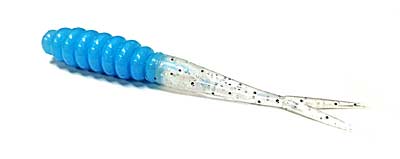
Mueller custom pours most of the soft-plastic lures he uses in cold water. While he’s used Do-It molds for lead baits for years, he’s only recently begun pouring soft plastics. Most are 3 inches or shorter, much smaller than most bass anglers’ finesse worms. One of his favorites, Do-It’s ES Crappie Fluke, measures 2 3/4 inches.
Custom pouring lets Mueller control the style and color of his soft-plastic lures. Making them follows the same process for all soft plastics, but he prefers Do-It’s soft formula plastic. “It’s a buoyant plastic, which I think is essential,” he said.
A bright idea
Glowing lures are popular with ice anglers because they generate more bites on slow days. “That’s all I had to see,” Mueller said. While there’s a lot of noise in the ice-fishing market for them, you don’t hear much discussion about them when it comes to open-water fishing. And that’s music to his ears.
Mueller has a couple of theories about why glowing lures work. “[Bass] can see them from further away,” he said. Their silhouette is less defined, too. “It creates an illusion,” he said. It’s the same tact as choosing a translucent topwater lure on a bright day when fishing clear water. Light passes through it, so the bass can feel its action but can’t see it. And the only way to find out if it’s food is to bite it.
Mueller matches his glowing soft plastics with jig heads coated in powder paint that glows. He prefers a white glow, which appears green underwater in the deepest depths. His second favorite is chartreuse glow, and he occasionally uses red glow when targeting smallmouth.
The lures only glow after being exposed to light. Mueller charges them with a headlamp or the flashlight function on his smartphone. “You can use the light of a graph, too,” he said. One charge lasts a good while, he said.
Mueller makes other lures glow. He’ll coat the lead portion of a gold blade bait with glow powder paint. When he headed to Lake Eufaula for a recent Bassmaster Elite Series event, he brought some large hair jigs — a popular lure at the impoundment that straddles the Alabama-Georgia line — that he tied on heads covered in glow powder paint. He didn’t know if they’d produce, but he was sure they were something its bass hadn’t seen.
Tune rods and line
You still deal with ice even if your favorite wintertime fishing hole has open water. Most fishing lines carry water into your rod’s line guides and casting reel’s level wind, where it freezes, locking them up solid. You’re forced to keep dipping your rod in the water or putting it and your reel next to a portable heater to thaw them out.
Mueller said the coating on Gamma’s Torque Ice Braid line sheds water, slowing ice buildup. That lets you fish longer before dealing with iced-up gear. “It’s nice to have when fishing braid to a fluorocarbon leader,” he said.
Ice fishing demands short rods, between 24 and 30 inches long. Mueller said that trend carries over to cold open water, but not to that extreme. Most of the year, he uses rods 7 feet or longer. They cast lures farther and pick up more lines on hook sets and during presentations. But cold-water bass don’t move far for a meal. So, to keep his lure movements short, he prefers a 6 feet, 8 inches long rod. “It’s all about matching the strike zone, using the right equipment to move the lure correctly,” he said.
BassResource may receive a portion of revenues if you make a purchase using a link above.


